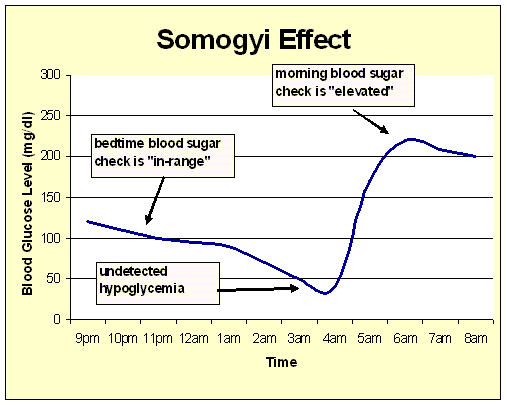Sometimes, doing a large amount of high-intensity exercise while on a ketogenic diet can result in a "Funny turn", i.e. a weird feeling which may include sweating, dizziness & feeling faint.
The good news is that it's harmless, provided you don't faint, hit your head on something hard/sharp & fatally fracture your skull, or do it regularly. Stop and sit/lie down until the feeling passes. What's happening?
What
isn't happening, is a
Somogyi rebound. A Somogyi rebound happens when too much insulin is injected and it's bad because it results in
rebound hyperglycaemia.

Did you know that there is insulin, insulin and insulin? According to
Insulin: Degradation, "It has been estimated that an insulin molecule produced endogenously by the pancreatic beta cells is degraded within approximately one hour after its initial release into circulation (insulin half-life ~ 4–6 minutes)". According to
Insulin: As a medication, injected insulin lingers in the blood for hours for fast-acting and days for slow-acting. This makes an overdose of injected insulin dangerous, as it can linger for long enough to cause fatal hypoglycaemia unless medical help is obtained.
What
might be happening, is this: On a ketogenic diet, muscle glycogen stores are "trickle-charged" from blood glucose. High-intensity exercise oxidises muscle glycogen at a
very rapid rate. See
It's all in a day's work (as measured in Joules). Muscles can oxidise carbs at a rate of
4g per minute.
If muscle cells run out of stored glycogen, they become exquisitely sensitive to insulin and glucose importing processes are up-regulated.
There is only ~4.5g of glucose in the blood at any given time, topped-up by
the liver & kidneys and oxidised by the brain & red blood cells at a rate of less than
4g per hour (if keto-adapted). If muscles suddenly take up glucose at a rate of
4g per minute, blood glucose level can fall rapidly.
As dropping dead due to running for your life on very little or no food is bad, the body has several mechanisms for raising blood glucose.
From
Blood Glucose, Insulin & Diabetes, "When BG falls to ~3.3mmol/L, the
pituitary gland kicks-in and secretes
ACTH (adrenocorticotropic hormone) which stimulates the release of
cortisol from the adrenal cortex. Cortisol further stimulates
gluconeogenesis in
the liver & kidneys. When BG level falls to ~2mmol/L, the pituitary secretes
GH (Growth Hormone) which has an anti-insulin effect."
Adrenaline secretion increases, as adrenaline shifts fuel utilisation away from carbohydrate and towards fat. A sudden increase in the levels of adrenaline, cortisol & GH in the blood make you sweaty, dizzy & feel faint, so you stop exercising.
If it happens regularly, chronically-elevated adrenaline & cortisol levels result in you "falling apart" after about two years. See
Survival of the Smartest (part 2) - Dr Diana Schwarzbein.
How come it's harmless? Glycogen-depleted & exquisitely insulin-sensitive muscles act as a natural blood glucose limiter because they draw in glucose so readily.
There's no rebound hyperglycaemia.
This also reduces the "
Dawn Phenomenon", another plus point for low-carb diets for people with T1D.
See also
Can very-low-carb diets impair your mental faculties.
 I haven't the foggiest idea! I found the image using Google Image search and it's called blurry-1.jpg.
I haven't the foggiest idea! I found the image using Google Image search and it's called blurry-1.jpg.













